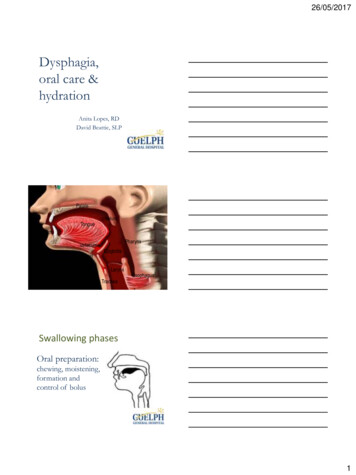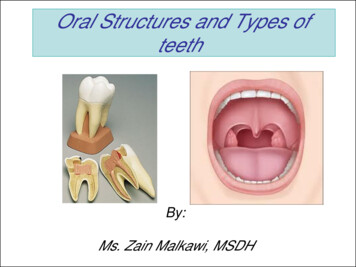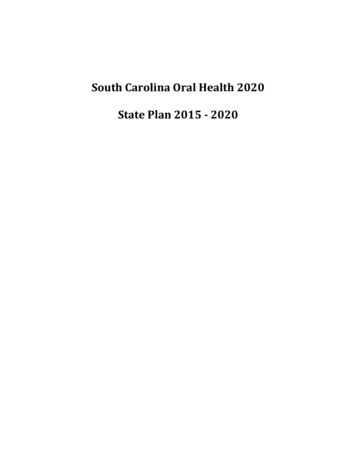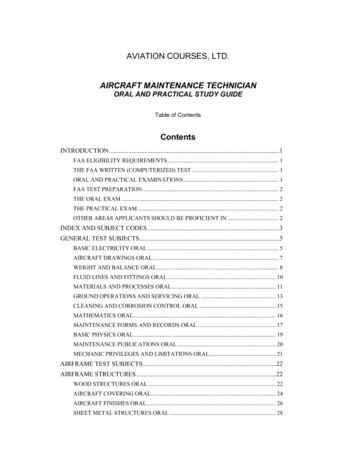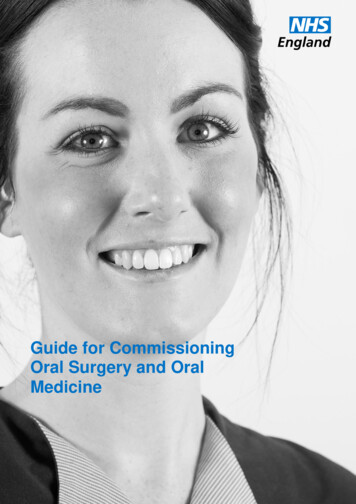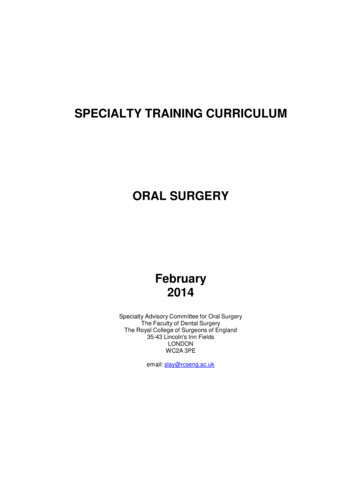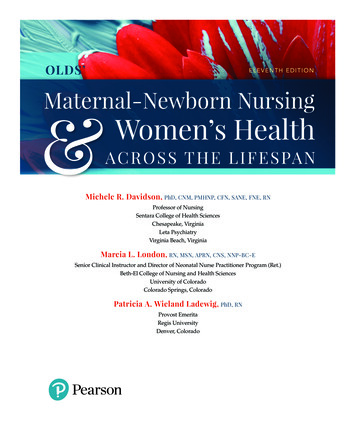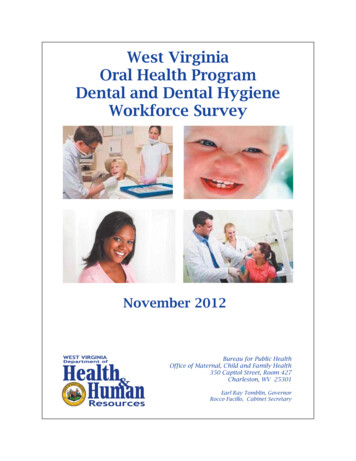
Transcription
West VirginiaOral Health ProgramDental and Dental HygieneWorkforce SurveyNovember 2012Bureau for Public HealthOffice of Maternal, Child and Family Health350 Capitol Street, Room 427Charleston, WV 25301Earl Ray Tomblin, GovernorRocco Fucillo, Cabinet Secretary
West Virginia Dental and Dental HygieneWorkforce SurveyEarl Ray TomblinGovernorRocco FucilloCabinet SecretaryMarian Swinker, MDCommissioner, Bureau for Public HealthAnne Williams, RN, BSN, MS-HCADirector, Office of Maternal, Child and Family HealthDecember 2012
Jason Roush, DDS, State Dental DirectorOral Health ProgramDeonna Williams, MS, CHES, CoordinatorOral Health ProgramChristina Mullins, MA, DirectorInfant, Child and Adolescent HealthKathy Cummons, MSW, ACSW, DirectorResearch, Evaluation and PlanningMelissa Baker, MA, EpidemiologistResearch, Evaluation and PlanningRichlyn Yond, MPHResearch, Evaluation and PlanningSpecial Thanks To:West Virginia Board of Dental ExaminersWest Virginia Dental AssociationWest Virginia University School of DentistryDental Workforce SubcommitteeGina Sharps, MPH, RDH – Marshall UniversityChuck Smith, DDS – West Virginia Dental AssociationLouise Veselicky, DDS, MSD – West Virginia University School of DentistryWVDHHR/BPH/OMCFH/ICAH/Oral Health Program Dentist and Dental Hygienist Survey 11-20122
IntroductionThe Oral Health Program within the Office of Maternal, Child and Family Health, Bureau forPublic Health, and Department of Health and Human Resources is committed to the promotionand improvement of the oral health of all West Virginians. In order to better serve the citizensof West Virginia, the State Oral Health Plan was created by the Oral Health Program with theinput of the West Virginia Oral Health Advisory Board and other community partners.The Oral Health Program utilizes the State Oral Health Plan as its primary planning tool, and hasbeen working to achieve the objectives set forth in the plan. Priorities include a multitude oftopics, the dental workforce being among those in the forefront. Objective four of the OralHealth Plan calls for the Program to strengthen and improve the dental health workforce.In response, a survey was created by the West Virginia University School of Dentistry and theOral Health Program. The survey was distributed to West Virginia dentists and dentalhygienists during the 2012 license renewal by the West Virginia Board of Dental Examiners. Theprimary purpose of this voluntary survey was to gain insight on clinically active dentists anddental hygienists working in the State.Prior to this survey, the oral health community had studied the geographical distribution ofdentists in West Virginia (see the following map). However, no one had studied the retirementplans, barriers to practice, utilization of dental hygienists or other key factors in their decisionto continue offering clinical services. This study will help to guide future activities to assure theavailability of a qualified oral health workforce well into the future.WVDHHR/BPH/OMCFH/ICAH/Oral Health Program Dentist and Dental Hygienist Survey 11-20123
MethodsThe West Virginia Dental and Dental Hygiene Workforce Surveys were administered in January2012 through the West Virginia Board of Dental Examiners (WVBDE) in cooperation with theWest Virginia University School of Dentistry and the West Virginia Department of Health andHuman Resources, Oral Health Program. These optional surveys were sent out to all dentistsand hygienists licensed by the WVBDE to be completed and returned with their re-licensureapplication.The WVBDE sent 1,236 surveys to dentists seeking license renewal. The Program had anacceptable return rate at 57% (706 surveys). In addition, 1,335 surveys were sent to dentalhygienists also seeking license renewal. The response rate was also acceptable for this group at53% (708 surveys).ResultsThe findings from the two surveys are summarized below:Dentist SurveyRespondents were 73% male and 22% female. Ninety-four percent of respondents were white,1% was black, and 5% other. Among the respondents, 81% of dentists graduated from WestVirginia University School of Dentistry while only 18% graduated from other schools.Dental BPH/OMCFH/ICAH/Oral Health Program Dentist and Dental Hygienist Survey 11-20124
Forty-seven percent of respondents were born prior to 1956, 21% were born between 1957and 1966, 14% between 1967 and 1976 and 18% born since 1977. Nearly half of all licenseddentists are over the age of 56 years.Year of Birth21Prior to 19561957 -1966141967-197647After 197718Twenty-six percent of respondents were awarded degrees prior to 1980.Number Awarded Degree by Year DHHR/BPH/OMCFH/ICAH/Oral Health Program Dentist and Dental Hygienist Survey 11-201245
Thirteen percent of respondents had a current West Virginia license but did not practicedentistry. The most common reason that respondents offered for not practicing was becausethey were retired (25%). Fifty-seven percent had other reasons for not practicing. This shouldbe further explored in future surveys as it is unclear if there are common reasons within thissub-category for not practicing.Why Not ce2010Liability7Other5320The majority of licensed dentists (67%) practice in the area of general dentistry.respondents self-identified as specializing in oral / maxillofacial radiology.NoCurrent Practice AreaGeneral Dentistry67 % Dental Public Health2%Orthodontics6%Educator / Academic2%Oral / Maxillofacial Surgery6%Prosthodontics1%Pediatric Dentistry3%Other1%Endodontics3%Oral / Maxillofacial CAH/Oral Health Program Dentist and Dental Hygienist Survey 11-20126
Over half of the respondents described their current practice setting as solo practice. Twentysix percent have a group practice and the remaining 22% practice in VA hospital/military,academic/teaching institute, state/local government and other, respectively.Current Practice Setting6052Solo practice50Group practice40Academic/teaching30FQHC26VA hospital/military20State/local government10547321OtherBlank0Of those whose primary occupation was that of a private practice, 66% of dentists describedtheir role as owners, 7% as associates, 4% as independent contractors, 3% as non-owners, and1% as other.Private Practice H/Oral Health Program Dentist and Dental Hygienist Survey 11-20127
When asked how many years they had been in their current primary practice setting/position,43% indicated they had been in their current setting/position for 20 or more years.Years in Current 56-1020 BlankEighty five percent of the dentists were accepting new patients while 6% were not acceptingnew patients at the time of the survey.Accepting New Patients6%85%9%WVDHHR/BPH/OMCFH/ICAH/Oral Health Program Dentist and Dental Hygienist Survey 11-2012YesNoBlank8
The majority of dentists (57%) reported that they treated more than 100 patients per month.Patients Treated Per 00 BlankQuestioned about the types of government programs respondents participated in at the timeof the survey, CHIP (56%), Medicaid-child (55%), adult Medicaid-emergencies (32%), TANF(30%), worker’s comp (19%), donated denture program (14%) and other (10%) were named asprograms in which the dentists participated.Participation in Government Programs605655CHIP50Medicaid - Child4032Adult Medicaid-Emergency30TANF302019Worker's Comp1410100Donated DentureOtherWVDHHR/BPH/OMCFH/ICAH/Oral Health Program Dentist and Dental Hygienist Survey 11-20129
Twenty-nine percent of respondents stated that they treated no Medicaid patients per month,39% treated 1 - 50 Medicaid patients per month and 18 % treated more than 15 patients permonth.Medicaid Patients Treated Per 100100 BlankOf the dentists who accept Medicaid, only 46% accepted new patients with this benefit. Fortypercent of respondents did not accept new Medicaid patients, which may cause barriers to oralhealth care.Accepting New Medicaid Patients40Yes14NoBlank46WVDHHR/BPH/OMCFH/ICAH/Oral Health Program Dentist and Dental Hygienist Survey 11-201210
The most commonly reported reasons for not accepting new Medicaid patients were lowcompensation (29%) and broken appointments (26%).Reasons For Not Accepting New Medicaid Patients403029261820171210119440Low compensationBroken apptsToo much paperworkBilling requirementsNot cover specialty servicesFull practiceFraud concernsLiability concernsOtherMost dentists (61%) reported that they employ a dental hygienist in their practice. However,only 46% employed a hygienist full-time. Of those who did not hire a dental hygienist, 2%reported that none were available, 7% reported it was their personal choice, 6% reported thattheir patient base did not support the employment and 11% had other reasons.Yes - Employ Dental eWVDHHR/BPH/OMCFH/ICAH/Oral Health Program Dentist and Dental Hygienist Survey 11-201211
Given the tenured workforce of the survey respondents, it is very important to understand theirplans for future dental practice. When asked, 261 (37%) of respondents reported that theyplan to retire within the next ten years.Retirement PlansRetire / Leave 1 year605050Retire / Leave 1-5 years40Retire / Leave 6-10 years301720Reduce Hours Next 5 years181110202No Plans to Retire / LeaveNext 10 YearsBlankFifty-eight percent of respondents were not interested in recruiting other dentists to replacethem, 12% had searched and found success in recruiting a dentist, 6% searched but did nothave any success while 11% did not try to recruit anyone but indicated that they would like torecruit a dentist.WVDHHR/BPH/OMCFH/ICAH/Oral Health Program Dentist and Dental Hygienist Survey 11-201212
Hygienist SurveyRespondents were 89% female, 1% male and 10% unknown; 91% were white, 1% black and 8%were other. The hygiene school with the highest percentage of graduates for this survey wasWest Liberty University 26%. West Virginia University was second at 24% followed byBridgemont at 17%.Hygiene School3026242524201715810510West LibertyWVUBridgemont Southern WVOtherUnknownThirty-six percent of licensed hygienists graduated since 2001, as compared to 22% of thelicensed dentists. In addition, 4% of respondents were born prior to 1950, 29% between 1950and 1965, 36% between 1966 and 1980, and 25% since 1981.Number Awarded Degree by OMCFH/ICAH/Oral Health Program Dentist and Dental Hygienist Survey 11-20122813
At the time of the survey, 22% of the dental hygienists were licensed but not practicing. Fiftysix percent of respondents indicated “other” as the reason they are not working. However, it isnoteworthy that 17% of respondents were unable to secure employment.Why Not Practicing60Unable to 1010Job Related HealthIssues103Other30The majority of dental hygienists (78%) indicated that they are employed in either a solo orgroup practice.Current Practice Setting50Solo practice49Group PracticeFQHC4030Academic / Teaching29State / Local Government2013OtherVA Hospital / Military1022221Blank0WVDHHR/BPH/OMCFH/ICAH/Oral Health Program Dentist and Dental Hygienist Survey 11-201214
General dentistry is the most common practice area (69%) for hygienist respondents.Current PracƟce Area80General denƟƐtry6970Pediatric denƟƐtry6050PeriodonƟcƐ40Dental public ty-three percent of respondents have been in their current position for ten years or less.Years in Current Setting / 020 WVDHHR/BPH/OMCFH/ICAH/Oral Health Program Dentist and Dental Hygienist Survey 11-2012Blank15
Many West Virginia dental hygienists work part-time. Seventeen percent of hygienists workedless than 20 hours per week while 54% work more than 21 hours. Eighty-four percent ofhygienists treat more than fifty patients per month.Patients Treated Per 1-100100 BlankSeventeen percent of the respondents indicated that they were seeking additional employmentas a dental hygienist. Kanawha (22%), Ohio (13%), and Monongalia (12%) were the top threecounties of choice for those seeking additional employment. In addition, respondents wereasked about the kind(s) of difficulty they experienced as it relates to finding a job. Twenty-twopercent said that they were looking but could not find full-time employment and 15% werelooking but could not find part-time employment. Salary, benefits and commuting distancewere the most common concerns.50Difficulties in Finding Position484030202215201514710460None ReportedLooking/cannot find part-timeTravel time/distance too greatUnsatisfactory work environmentOtherLooking/cannot find full-timeInadequate benefitsInadequate salaryDays requiredWVDHHR/BPH/OMCFH/ICAH/Oral Health Program Dentist and Dental Hygienist Survey 11-201216
FiŌy-ĮǀĞ percent of hygienists indicated that they have no plans to stop working in the next tenyears. Of those who plan to stop pracƟcing in the next ten years (25%), the most commonreasons included: reƟƌement (17%), family commitments (4%), career change (2%), and 5%indicated other reasons.Future Plans60Stop in 1 year5550Stop 3-5 years40Stop 6-10 years30Reduce hours next 5 years1920141061No plans to stop next 10years4Blank0ConclusionThe survey results demonstrated that the vast majority of denƟsts were educated at WestVirginia University (81%); however, the proporƟon of dental school graduates that remain inthe State aŌer the compleƟon of their degree is decreasing. According to the West VirginiaUniversity School of DenƟƐtry, only 12.5% of the 2011 graduates remained in West Virginiaupon graduaƟon, compared to 27.5% in 2010 and 42% in 2009. AddiƟonally, 37% of denƟƐts inWest Virginia plan to reƟƌĞ in the next ten years. Key Įndings of the denƟƐt survey aresummarized below:·····Eighty-one percent of denƟsts currently pracƟcing in West Virginia graduated from theWest Virginia University School of DenƟƐtry.Thirteen percent of denƟƐts were not pracƟcing at the Ɵŵe of this study. Of those, onlyseven percent indicated that they were not pracƟcing due to the inability to secureemployment.Sixty-seven percent of West Virginia denƟsts are general denƟsts.Thirty-seven percent of denƟƐts in West Virginia plan to reƟƌĞ in the next ten years.Seventeen percent of denƟƐts are interested in recruiƟng a denƟst to replace them aŌerreƟƌĞment.WVDHHR/BPH/OMCFH/ICAH/Oral Health Program DenƟst and Dental Hygienist Survey 11-201217
The majority of hygienists were educated at West Virginia University and West LibertyUniversity. Only twenty-one percent of hygienists plan to stop pracƟcing in the next 10 years.Key Įndings of the hygienist survey are summarized below:···FiŌy percent of dental hygienists currently pracƟcing in West Virginia are West VirginiaUniversity and West Liberty alumni.One-fourth of dental hygienists were not pracƟcing at the Ɵŵe of this study, but only17% indicated that an ability to secure employment was a barrier.FiŌy-ĮǀĞ percent of hygienists indicated that they have no plans to reƟƌĞ in the next tenyears.Next StepsAs a result of the Įndings in this study and the in-state retenƟon rates of the West VirginiaUniversity School of DenƟƐtry graduates, the Oral Health Program has developed the DentalWorkforce Loan Reimbursement Program. This program is targeted to West Virginia Universitygraduates wishing to pracƟce denƟƐtry in West Virginia. ParƟcipants must be willing to pracƟcein a Dental Health Professional Shortage Area and may obtain up to 50,000 in loan repaymentover a two year period. In addiƟŽn, a technical assistance team comprised of a denƟƐt,hygienist, billing specialist, and oĸce manager will be available to assist dental pracƟces in ruralcommuniƟĞƐ to maximize paƟent services and develop sustainable dental pracƟces. Thisprogram is funded through a grant award from the Health Resources and ServicesAdministraƟon (HRSA).WVDHHR/BPH/OMCFH/ICAH/Oral Health Program DenƟst and Dental Hygienist Survey 11-201218
West Virginia Oral Health Program350 Capitol StreetRoom 427Charleston, West Virginia lhealth
The majority of licensed dentists (67%) practice in the area of general dentistry. No respondents self-identified as specializing in oral / maxillofacial radiology. Current Practice Area General Dentistry 67 % Dental Public Health 2 % Orthodontics 6 % Educator / Academi

